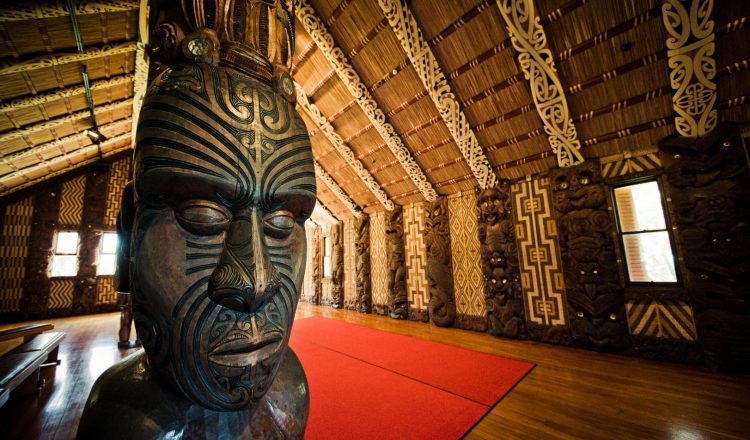Nghệ thuật Maori
Với niềm tin sâu sắc rằng nghệ thuật và sự sáng tạo là phương tiện của các vị thần, nghệ thuật và hàng thủ công của người Maori là một phần thiêng liêng trong văn hóa của họ và là một trong số ít các khía cạnh của cuộc sống Maori có thể được công nhận trên khắp thế giới. Người Maori tin rằng quá khứ là tương lai, hiện tại là một vòng lặp. Vì lý do này, nhiều hoạt động nghệ thuật truyền thống cố gắng giữ các kỹ thuật của tổ tiên càng nhiều càng tốt. Sự tôn nghiêm của nghệ thuật không chỉ nằm ở sự sáng tạo của nó, mà còn ở sự truyền lại qua nhiều thế hệ.
Pounamu (đá xanh)
Pounamu hay greennstone là một loại đá cứng bền, được trân trọng trong văn hóa Maori. Theo truyền thống, đá xanh có thể là ngọc bích nephrite, bowenite hoặc serpentinite; tuy nhiên, ngọc bích nephrite là dạng đá phổ biến nhất hiện nay. Người Maori coi pounamu là taonga, báu vật thiêng liêng của người Maori. Do đó, các khu vực mà bạn có thể tìm thấy greennstone, thường được bảo vệ bởi luật pháp của chính phủ, với iwi địa phương chịu trách nhiệm phân phối.
Người Maori sử dụng pounamu cho các công cụ và đồ trang trí. Khi công cụ trở nên quá cũ để sử dụng, họ chuyển đá thành đồ trang sức. Có một món đồ làm bằng đá xanh được coi là để nâng cao uy tín trong xã hội Maori, nhưng việc mua hoặc chạm khắc nó cho chính mình có thể mang lại xui xẻo! Những chiếc vòng cổ và đồ trang sức bằng đá xanh vẫn rất phổ biến trên khắp thế giới. Disney đã đề cập đến tầm quan trọng của đá xanh trong bộ phim Moana của họ.
Whakairo (điêu khắc)
Nghệ thuật điêu khắc hay còn gọi là Whakairo vẫn là một phần thiết yếu trong cuộc sống hàng ngày của người Maori. Theo truyền thống, gỗ, đá và xương được sử dụng cho mục đích điêu khắc, cũng như đá xanh. Phong cách điêu khắc khác nhau giữa các iwi, nhưng whakairo lấy ảnh hưởng từ thiên nhiên và vật liệu được sử dụng. Gỗ là vật liệu chạm khắc phổ biến nhất của người Maori, vì theo truyền thống họ thường sử dụng gỗ địa phương để tạo ra waka (xuồng) của họ. Khắc gỗ vẫn là một phần quan trọng của văn hóa Maori hiện đại khi họ sử dụng nó để trang trí cho Marae. Việc chạm khắc xương thường sử dụng xương cá voi và được sử dụng để làm các công cụ phức tạp như móc câu cá, hoặc đồ trang trí.
Các bức chạm khắc Maori thường miêu tả cơ thể con người, hoặc Manaia, một con rắn đầu chim đóng vai trò như một người giám hộ. Nghệ thuật whakairo mang tính tinh thần sâu sắc và ngày nay vẫn được lưu truyền.
Raranga (dệt)
Nghề dệt của người Maori, hay Raranga, không chỉ là việc tạo ra quần áo và hàng may mặc. Đó là một thực hành truyền thông điệp từ các vị thần thông qua nghệ sĩ. Đây là một nghệ thuật thiêng liêng đã được truyền qua nhiều thế hệ và vẫn được giảng dạy trong tư nhân hoặc thậm chí ở cấp đại học ở New Zealand.
Cây lanh thường là chất liệu được lựa chọn, vì những người thợ dệt tạo ra những bộ quần áo phức tạp đẹp mắt, những chiếc giỏ, đồ treo tường và nhiều hơn thế nữa. Các thành viên của cộng đồng Maori mặc quần áo được làm bằng kỹ thuật dệt truyền thống trong các buổi lễ. Những người biểu diễn mặc chúng để tăng uy tín của họ và tuyên bố các phần của di sản của họ. Dệt may của người Maori thường sử dụng các màu có sẵn tự nhiên như đen, trắng và vàng, nhưng trong thời hiện đại, thuốc nhuộm đôi khi được sử dụng để nâng cao chất lượng sản phẩm.
Ta Moko (hình xăm)
Nói rằng Ta Moko chỉ là nghệ thuật xăm mình trong văn hóa Maori sẽ là một cách nói nhỏ. Đó là một thực tế rất đặc biệt đối với những người lựa chọn cam kết với nó. Hình xăm người Maori tương tự như các thiết kế bộ lạc khác của người Polynesian nhưng không chỉ phục vụ một mục đích thẩm mỹ. Hình xăm trên mặt và cơ thể nói một ngôn ngữ thị giác và có thể truyền đạt thông tin về người, bộ tộc, lịch sử và vị thế xã hội của họ. Thông điệp bộ lạc này được mặc với niềm tự hào văn hóa và thể hiện sự toàn vẹn của người Maori. Cả nam lẫn nữ đều có thể xăm mình, với những hình xăm mặt giữ danh dự cao nhất, vì người đứng đầu được coi là thiêng liêng trong văn hóa Maori. Những hình xăm trên khuôn mặt nhấn mạnh những biểu hiện có thể dẫn đến những người không quen thuộc với họ tìm thấy những hình xăm hơi đáng sợ. Điều này không cần phải là trường hợp vì họ phục vụ chủ yếu như là một tuyên bố về bản sắc và thậm chí có thể thúc đẩy những thay đổi trong lối sống của người Maori để sống phù hợp với các thông điệp mà hình xăm của họ truyền tải.

















































